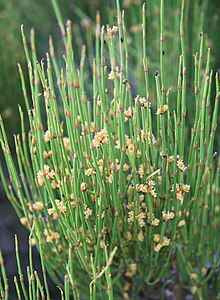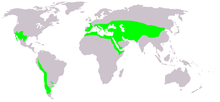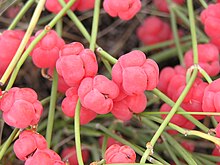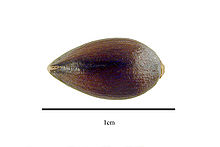
Ephedra distachya is a shrub in the family Ephedraceae that stands about 25 cm to 50 cm high. The shrub grows in many parts of the world, including southern and central Europe and western and central Asia. Its local names include somlatha. Ephedra distachya lives on grey dunes which are fixed and stable sand dunes that are covered in continuous vegetation.

Ephedraceae is a family of gymnosperms belonging to Gnetophyta, it contains only a single extant genus, Ephedra, as well as a number of extinct genera from the Early Cretaceous.

Gnetophyta is a division of plants, grouped within the gymnosperms, that consists of some 70 species across the three relict genera: Gnetum, Welwitschia, and Ephedra. The earliest unambiguous records of the group date to the Jurassic, and they achieved their highest diversity during the Early Cretaceous. The primary difference between gnetophytes and other gymnosperms is the presence of vessel elements, a system of small tubes (xylem) that transport water within the plant, similar to those found in flowering plants. Because of this, gnetophytes were once thought to be the closest gymnosperm relatives to flowering plants, but more recent molecular studies have brought this hypothesis into question, with many recent phylogenies finding them to be nested within the conifers.

Ephedra is a medicinal preparation from the plant Ephedra sinica. Several additional species belonging to the genus Ephedra have traditionally been used for a variety of medicinal purposes, and are a possible candidate for the soma plant of Indo-Iranian religion. It has been used in traditional Chinese medicine, in which it is referred to as Ma Huang, for more than 2,000 years. Native Americans and Mormon pioneers drank a tea brewed from other Ephedra species, called "Mormon tea" and "Indian tea".
There has been much speculation as to the botanical identity of soma or haoma. Soma is a plant described in Hindu sacred texts including the Rigveda, while haoma is a plant described in the Avesta, a collection of Zoroastrian writings. Both names are derived from the Proto-Indo-Iranian *Sauma. Proposed candidates include various species of plants and or fungi. Traditional etymology of Indian Soma is Somalata used traditionally by the Srauta Brahmins called Somayajis whereas the Avestan Haoma is an Ephedra, which are totally unconnected species sourced from different areas. European researchers suggest other plants, such as the perennial Peganum harmala, Nelumbo nucifera, Cannabis sativa, and the sugarcane species Tripidium bengalense ; while fungal candidates include the fly-agaric mushroom Amanita muscaria, the psilocybin-containing mushroom Psilocybe cubensis, and the ergot fungus Claviceps purpurea. Other scholarly proposals include mixtures of these candidates with each other and with other substances.

Ephedra sinica is a species of Ephedra native to Mongolia, Russia, and northeastern China.

Ephedra californica is a species of Ephedra, known by the common names California jointfir, California ephedra, desert tea, Mormon tea, and cañatillo.
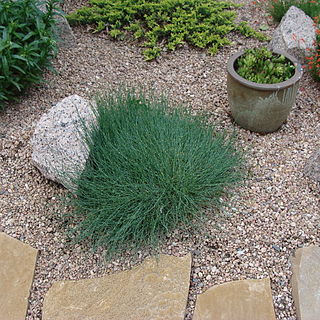
Ephedra funerea is a species of Ephedra, known by the common name Death Valley jointfir, Death Valley ephedra, or Mormon Tea.

Ephedra viridis, known by the common names green Mormon tea, green ephedra, and Indian tea, is a species of Ephedra. It is indigenous to the Western United States, where it is a member of varied scrub, woodland, desert, and open habitats. It grows at 900–2,300 metres (3,000–7,500 ft) elevations.
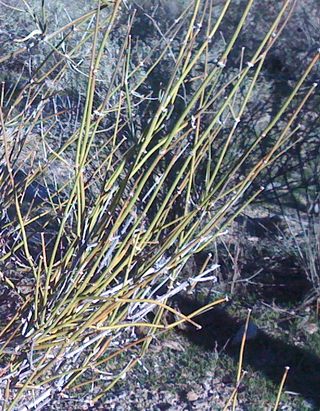
Ephedra fasciculata is a species of plant in the Ephedraceae family. Common names are Arizona ephedra, Arizona jointfir, and desert Mormon-tea.

Kobresia is a genus of plants in the sedge family. They are sometimes called bog sedges. These perennial sedges are quite similar to Carex species in appearance. The genus is widespread across much of Europe, Asia and North America, with many species native to the Himalayas.
Ephedra alata is a species of Ephedra. These plants are perennial and xerophytic gymnosperm shrubs.
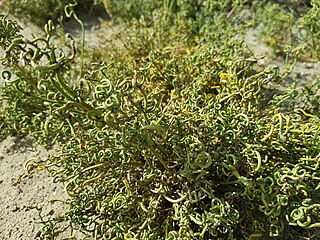
Ephedra przewalskii is a species of Ephedra that is native to Central Asia, Mongolia, Pakistan, and parts of China.

Ephedra torreyana, with common names Torrey's jointfir or Torrey's Mormon tea, is a species of Ephedra that is native to the deserts and scrublands of the Southwestern United States and to the State of Chihuahua and northern Mexico.
Ephedra lomatolepis is a species of Ephedra that is native to Kazakhstan, Mongolia, Xinjiang in China, and Tuva in Siberia.
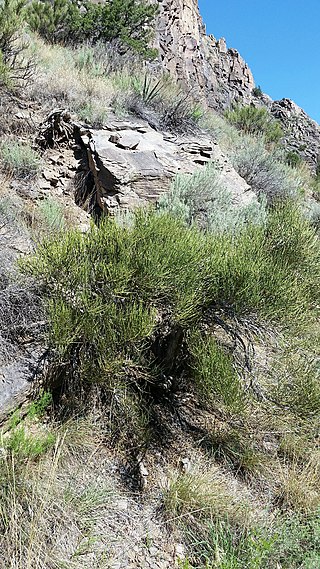
Ephedra cutleri, the Navajo ephedra or Cutler's jointfir, is a species of Ephedra that is native to the Southwestern United States.
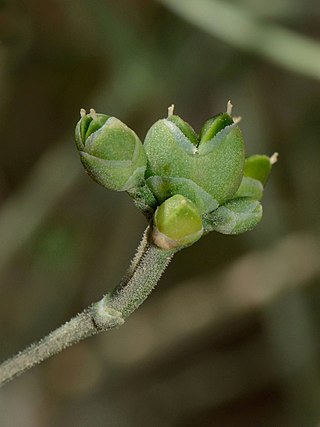
Ephedra foliata is a species of gymnosperm in the Ephedraceae family. It is referred to by the common name shrubby horsetail. It is native to North Africa, and Southwest Asia, from Morocco and Mauritania east to Turkmenistan, Pakistan, and Punjab State in India.
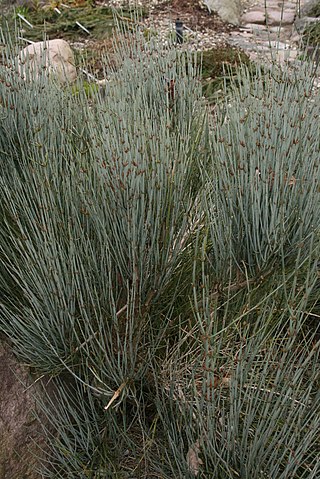
Ephedra intermedia, with the Chinese common name of Zhong Ma Huang, is a species of Ephedra that is native to Siberia, Central Asia, Iran, Afghanistan, Pakistan, the western Himalayas, Tibet, Mongolia, and China.

Ephedra nevadensis, commonly known as Nevada ephedra, gray ephedra, Mormon tea and Nevada jointfir, is a species of gymnosperm native to dry areas of western North America.
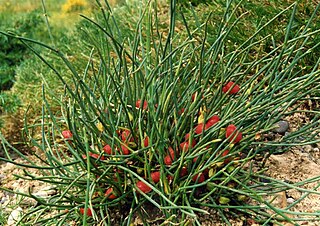
Ephedra monosperma, also called Ephedra minima or dan zi ma huang, is small shrub in the family of Ephedraceae.
